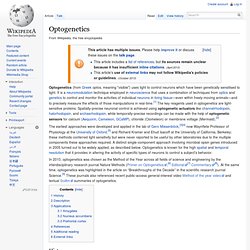

Optogenetics. The earliest approaches were developed and applied in the lab of Gero Miesenböck,[3][4] now Waynflete Professor of Physiology at the University of Oxford,[5] and Richard Kramer and Ehud Isacoff at the University of California, Berkeley; these methods conferred light sensitivity but were never reported to be useful by other laboratories due to the multiple components these approaches required.

A distinct single-component approach involving microbial opsin genes introduced in 2005 turned out to be widely applied, as described below. Optogenetics is known for the high spatial and temporal resolution that it provides in altering the activity of specific types of neurons to control a subject's behavior. In Optogenetics, Buttons for Neural Switchboards. Optogenetics Sheds Light on Parkinson's Disease. Optogenetics: controlling brain cells with lasers - life - 07 January 2010. Brain cells can be switched on and off like light bulbs using newly identified microbial proteins that are sensitive to the colour of laser light.

The discovery is the latest in the fast-moving field of optogenetics, which has already given researchers unparalleled control over brain circuits in laboratory animals. The technology may lead to treatments for conditions such as epilepsy, Parkinson's disease and blindness. New Scientist explains the science and its promise. How do scientists control brain cells with lasers?